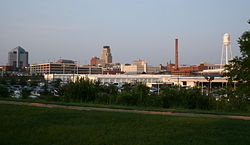Durham, North Carolina
| Durham, North Carolina | |||
 |
|||
|
|||
| Nickname(s): "Bull City", "City of Medicine" | |||
|
|
|||
| Coordinates: | |||
| Country | United States | ||
|---|---|---|---|
| State | North Carolina | ||
| Counties | Durham, Orange, Wake[1] | ||
| Government | |||
| - Mayor | Bill Bell | ||
| Area | |||
| - Total | 94.9 sq mi (245.8 km²) | ||
| - Land | 94.6 sq mi (245.1 km²) | ||
| - Water | 0.3 sq mi (0.7 km²) | ||
| Elevation | 404 ft (123 m) | ||
| Population (2007) | |||
| - Total | 217,847 | ||
| Time zone | EST (UTC-5) | ||
| - Summer (DST) | EDT (UTC-4) | ||
| Area code(s) | 919 | ||
| FIPS code | 37-19000[2] | ||
| GNIS feature ID | 1020059[3] | ||
| Website: www.durhamnc.gov | |||
Durham is a city in the U.S. state of North Carolina. It is the county seat of Durham County[4] and also extends into Orange and Wake counties.[1] It is the fifth largest city in the state by population, with 217,847 residents as of July 1, 2007.[1] It is the home of Duke University and North Carolina Central University, and is also one of the vertices of the Research Triangle area (home of the Research Triangle Park).[5]
Durham is the core of the four-county Durham, NC MSA, which has a population of 479,624 as of July 1, 2007. The US Office of Management and Budget also includes Durham as a part of the Raleigh-Durham-Cary Combined Statistical Area, which has a population of 1,635,974 as of July 1, 2007.
Contents |
History
Durham originated in 1853 with the search for a suitable railroad depot for the North Carolina Railroad between Raleigh and Hillsborough. The wood-burning steam locomotives of the time had to stop frequently to refuel, and depots supplying wood and water could not be more than 25-30 miles apart.
A post office known as Herndon's existed in the area from 1827, and another at nearby Prattsburg was established in 1836. The landowners at Prattsburg refused to sell land to the railroad. Somewhat further to the northwest in what was then part of Orange County, a country physician named Bartlett S. Durham lived and practiced along the route. He donated land to the railroad, which named the subsequent depot Durham Station. Prior to the arrival of the railroad, the area now known as Durham was almost entirely agricultural, with a few businesses catering to travelers (particularly livestock drivers) along the Hillsborough Road. This road, eventually followed by US Route 70, was the major east-west route in North Carolina from colonial times until the construction of interstate highways.
The community of Durham Station grew slowly before the Civil War, but expanded rapidly following the war; the present city charter dates from 1869. Much of this growth can be attributed to the establishment of a thriving tobacco industry. Soldiers, both Union and Confederate, were encamped near Bennett Place, just outside Durham Station, during surrender proceedings in April 1865. While on the battlefront, soldiers liberally helped themselves to the area's Brightleaf Tobacco, which purportedly had a milder flavor than other tobacco varieties. Veterans returned home after the war with an interest in acquiring more of the great tobacco they had sampled in North Carolina. Numerous orders were mailed to Green's tobacco company requesting more of the Durham tobacco. W.T. Blackwell partnered with Green and renamed the company as the "Bull Durham Tobacco Company". The name "Bull Durham" is said to have been taken from the bull on the British Colman's Mustard, which Mr. Blackwell (mistakenly) believed was manufactured in Durham, England.
20th century
The rapid growth and prosperity of the Bull Durham Tobacco Company, and Washington Duke's Duke & Sons Tobacco Company, resulted in the rapid growth of the city of Durham. While the tobacco industry dominated the city's economy initially, it was soon rivaled by the establishment of multiple textile mills, particularly in East and West Durham. Much of the early city architecture, both commercial and residential, dates from the period of 1890 - 1930.
Durham quickly developed a vibrant Black community, the center of which was an area known as 'Hayti' (pronounced HAY-tie), just south of the center of town, where some of the most prominent and successful black-owned businesses in the country during the early 20th century were established. These businesses — the best known of which are North Carolina Mutual Insurance Company and Mechanics & Farmers' Bank — were centered on Parrish St., which would come to be known as "Black Wall Street."
In 1924 James Buchanan Duke established a philanthropic foundation in honor of his father Washington Duke to support Trinity College in Durham. The college changed its name to Duke University and built a large campus and hospital a mile west of Trinity College (the original site of Trinity College is now known as the Duke East Campus).
Durham's manufacturing fortunes declined during the mid-20th century. Textile mills began to close during the 1930s. Competition from other tobacco companies (as well as a decrease in smoking after the 1960s) reduced revenues from Durham's tobacco industry. Although the region benefited significantly from the establishment of Research Triangle Park in 1958, Durham did not experience the same early increases in housing development as neighboring Raleigh and Cary. Suburban flight also contributed to the slow but progressive decline of downtown Durham as a retail and economic center.
With a strong African-American community, a strong Civil Rights movement developed in Durham. Multiple sit-ins were held, and Dr. Martin Luther King Jr. visited the city during the struggle for equal rights. This strong community was not enough to prevent the demolition of portions of the Hayti district for the construction of the Durham Freeway during the late 1960s. The freeway construction resulted in losses to other historic neighborhoods, including Morehead Hills, West End, and West Durham. Combined with large-scale demolition using Urban Renewal funds, Durham suffered significant losses to its historic architectural base.

Durham's growth began to rekindle during the 1970s and 1980s, with the construction of multiple housing developments in the southern part of the city, nearest Research Triangle Park, and the beginnings of downtown revitalization. In 1975, the St. Joseph's Historical Foundation at the Hayti Heritage Center was incorporated to "preserve the heritage of the old Hayti community, and to promote the understanding of and appreciation for the African American experience and African Americans' contributions to world culture."[6] A new downtown baseball stadium was constructed for the Durham Bulls in 1994. A large-scale renovation of the historic American Tobacco Company (formerly Bull Durham) complex commenced in 2003.
Major employers in Durham are Duke University (39,000 employees, 13,000 students), about 2 miles west of the original downtown area, and companies in the Research Triangle Park (49,000 employees), about 10 miles southeast. These centers are connected by the Durham Freeway (NC 147).
Education

Colleges and universities
- Duke University - private research university
- North Carolina Central University - public historically black university
- Shaw University - College of Adult Professional Education
- Durham Technical Community College - public two-year accredited institution
Public education in Durham is provided by Durham Public Schools. Durham owns 45 schools, including a school for hospitalized children. Durham also is home to the state-run residential high school North Carolina School of Science and Mathematics.
In December 2007, Forbes.com ranked Durham as one of the "Top 20 Places to Educate Your Child;" Durham was the only MSA from North Carolina to make the list.[7][8]
Sports and Entertainment
Durham's most famous professional sports team is the Durham Bulls International League baseball team. A movie involving the franchise, Bull Durham, was produced in 1988. The Bulls play in the Durham Bulls Athletic Park, on the southern end of downtown, constructed in 1994. Designed by HOK-Sport, the designers of Oriole Park at Camden Yards in Baltimore, the stadium has 10,000 seats and is fronted by an office building, Diamond View I, built by the owner of the team, Raleigh's Capital Broadcasting. Construction of a second Diamond View office building and parking deck is now complete. Now with one of the newest and most impressive stadiums in the minor leagues, the Bulls usually generate an annual attendance of around 500,000. Previously the Durham Athletic Park, located on the northern end of downtown, had served as the team's homebase. It has been preserved for the use of other minor league baseball teams as well as for concerts sponsored by the City of Durham and other events. The Durham Dragons, a women's fast pitch softball team, played in the Durham Athletic Park from 1998-2000.
NCAA Sports
Duke University offers 26 NCAA Division I sporting teams and competes in the ACC. Duke has won 3 NCAA Division I Men's Basketball Championships, and is third in NCAA Final Four appearances in Men's Basketball with 14.
North Carolina Central University offers NCAA Division I sporting teams and currently in transition to compete in the MEAC.
NCCU has won CIAA championships in football, volleyball, and cross country for two consecutive years. NCCU won the 1989 NCAA Division II Men's Basketball Championship.
The city also owns a national landmark downtown, the Carolina Theatre, which is operated by a nonprofit organization. The Carolina Theatre is the host of the Full Frame Documentary Film Festival. The Full Frame Documentary Film Festival caters to documentary film makers all over the world. In addition, the American Dance Festival, a six-week series of dance performances, is held each summer at the Duke University Campus.
Amateur sports
The Carolina ANZACs[9] cricket and social group is based in this area and participate in many invited tournaments all around the country and are part of the Mid Atlantic Cricket Conference, a member league of the USACA.
The Carolina ANZACs actively promote kids cricket in collaboration with other cricket clubs in the area and hold annual cricket camps for enthusiastic youngsters.
Points of interest
- American Tobacco Trail
 A dinosaur statue on the grounds of the Museum of Life and Science
A dinosaur statue on the grounds of the Museum of Life and Science - Bennett Place
- Brightleaf Square
- Carolina Theatre
- Catsburg Store
- Duke University
- Nasher Museum of Art
- Horton Grove (former slave cabins at Stagville Plantation)
- North Carolina Museum of Life and Science
- Sarah P. Duke Gardens
- Durham Central Park
- Historic Stagville Plantation
- The Streets at Southpoint
- West Point Mill
- American Tobacco Company (shops, restaurants)
- Ninth Street (interesting retail, bookshops, coffee shops, restaurants)
- Durham Bulls Athletic Park (Durham Bulls baseball stadium)
Culture

Events include jazz festivals, blues festivals, symphony concerts, art exhibitions, and a multitude[10] of cultural expositions, including the American Dance Festival and the Full Frame Documentary Film Festival. A center of Durham's culture is its Carolina Theater, which shows both live performances and films, primarily independent releases. Notable dining establishments are primarily concentrated in the Ninth Street, Brightleaf, and University Drive areas. There is a resurgence of restaurants in and around the downtown area, including several new restaurants in the American Tobacco District. The Nasher Museum of Art opened in October 2005 and has produced nationally-recognized traveling exhibitions of leading-edge global, contemporary art.
The Durham Association for Downtown Arts (DADA) is a non-profit arts organization located in the downtown area. It was founded in 1998 and then incorporated in 2000. The organization's mission is a commitment to the development, presentation and fiscal sponsorship of original art and performance in Durham. DADA strives to support local artists working in a diversity of artistic media. Emphasizing community, DADA helps local residents gain access to these artists by providing free or low-cost venue admission.
Movies filmed in Durham
- Three In The Attic 1967
- Brainstorm 1981
- Weeds 1987
- The White Girl 1987
- Bull Durham 1987
- The Handmaid's Tale 1990
- Once Around 1990
- Billy Bathgate 1991
- The Program 1992
- Painting Churches 1992
- The Portrait 1993
- Getting In 1993
- Bandwagon 1994
- Margaret 1994
- The Immortal 1994
- Chesterfield 1995
- Kiss the Girls 1996
- Clowns 1999
- The Rookie 2002
- Scenic 2003
- Majolie & Chouchou 2003
- Duchess of Durham County 2006
- Welcome to Durham, USA 2007. Upon its release and subsequent screenings at several film festivals, Welcome to Durham, USA created serious buzz and press with a relevant issue that few had touched upon. [11]
- Los Sueños de Angélica 2007. The first Latino feature film made in North Carolina.
For a complete listing of all television, video and commercials filmed in Durham, visit http://www.durham-nc.com/film/film_history.php
Famous natives and residents
Born in Durham
- Artist/painter Ernie Barnes
- Pastor & Gospel recording artist Shirley Caesar
- Major league baseball pitcher Roger Lee Craig[12]
- Hall of Fame college (NCCU) James M. DeVone, Sr.
- David Gergen, advisor to presidents Ford, Reagan, and Clinton
- Songwriter John D. Loudermilk ("Tobacco Road", "Then You Can Tell Me Goodbye")
- Pastor & Gospel Recording Artist John P. Kee
- Singer/songwriter Clyde McPhatter
- Songwriter Don Schlitz (Kenny Rogers's "The Gambler")
- Hip-Hop Artist/producer 9th Wonder
- Hall of Fame baseball player Rick Ferrell[13]
- NFL (2002-Present) quarterback, Jacksonville Jaguars David Garrard
- John H. Hager, former Virginia Lieutenant Governor (1998-2002) and the father-in-law of First Daughter Jenna Bush Hager
- NFL (1995-98) defensive end Carl Reeves
- Current major league baseball player Brian Roberts, second baseman for the Baltimore Orioles[14]
- NBA (1993-2005) power forward Rodney Rogers
- Former Undersecretary of the Treasury Robert K. Steel
- NFL (1994-2005) cornerback Dewayne Washington
- Olympic champion snowboarder Seth Wescott[15]
- Major League Baseball first baseman Josh Whitesell of the Arizona Diamondbacks
Residents of Durham
- Branford Marsalis has been a resident of Durham for several years. The Branford Marsalis Quartet's 2006 album Braggtown was titled after Braggtown Baptist Church, which sits in the neighborhood of Bragtown, located in northeastern Durham, just north of Highways 70/85.[16]
- Dr. LeRoy T. Walker, former United States Olympic President and former Chancellor of North Carolina Central University(NCCU), presently lives in Durham.[17]
- Christopher "Play" Martin, one-half of the rap and comedy duo Kid 'n Play. He now teaches at North Carolina Central University as a hip hop instructor in the music department.
- Mur Lafferty, podcaster and writer.
Associated with Durham
- Pulitzer Prize-winning cartoonist Doug Marlette lived in Durham as a child.[18]
Politics
The area is predominantly Democratic, and has voted for the Democratic Party's presidential candidate in every election since the city's founding in 1869. Durham is an activist community and politics are lively, visible, and often contentious, and like many communities, often dealing with issues of race and class. The shifting alliances of the area's political action committees since the 1980s has led to a very active local political scene. Notable groups include the Durham Committee on the Affairs of Black People, the Durham People's Alliance, and the Friends of Durham. Compared to other similarly sized Southern cities, Durham has a larger than average population of middle class African-Americans and white liberals. Working together in coalition, these two groups have dominated city and county politics since the early 1980s.
Key political issues have been the redevelopment of Downtown Durham and revival of other historic neighborhoods and commercial districts, a 45% reduction of crime, a 10 year plan to end homelessness, initiatives to reduce truancy, issues related growth and development. Naturally, a merger of Durham City Schools (several inner city neighborhoods) and Durham County Schools in the early 1990s has not been without controversy.
Recent issues
In 2006, racial and community tensions were stirred[19] following false allegations of a sexual assault by three white members of the Duke University lacrosse team in what is now known as the 2006 Duke University lacrosse case. The allegations were made by a young African- American woman, student and mother of two young children. She and another young lady had been hired to dance at a party that the team held in an off-campus house. In 2007, all charges in the case were dropped. Durham County District Attorney Mike Nifong was dismissed from his job and disbarred from legal practice for negligent handling of the case. There have been several other results from the case, including lawsuits against city and Duke University officials.
Immigration policy
Since 2003 the city has had a policy to prohibit police from inquiring into the citizenship status of persons unless they have otherwise been arrested or charged with a crime. A city council resolution mandates that police officers "...may not request specific documents for the sole purpose of determining a person's civil immigration status, and may not initiate police action based solely on a person's civil immigration status ..."[20]
Passenger transportation

- See also: Durham, North Carolina (Amtrak station)
- Private vehicle: Most travel in Durham is by private vehicle on public streets.
- Air: Raleigh-Durham International Airport is just east of Durham on I-40.
- Major highways: I-40, I-85, I-540and U.S.15, U.S. 501 and U.S. 70. Also, NC 147, the Durham Freeway.
- Passenger rail: Amtrak's Carolinian and Piedmont train offers daily service to Charlotte and Raleigh, where connections can be made to New York, Miami, Washington DC and New Orleans.
- Public transportation: Within Durham, the Durham Area Transit Authority (DATA) bus system. The Triangle Transit Authority operates buses that serve the region and connect to municipal bus systems in Raleigh and Chapel Hill.
- Trails: The American Tobacco Trail's northern terminus is in downtown Durham.
- Bicycle: All public buses are equipped with bicycle racks.
Media
Print media
There are several newspapers and periodicals that serve the Durham market:
- The Herald-Sun, a large daily newspaper now owned by the Paxton Media Group
- The News & Observer, a large daily newspaper published in nearby Raleigh and owned by The McClatchy Company that also distributes throughout Durham
- The Chronicle, the independent daily at Duke University
- Independent Weekly, a free weekly newspaper (also covers nearby Raleigh)
- Durham Flyer, a free monthly tabloid
Broadcast television
Durham is part of the Raleigh-Durham-Fayetteville Designated Market Area, the 28th largest broadcast television market in the United States. The following stations are licensed to Durham and/or have significant operations in the city:
- WTVD-TV (11, ABC): owned-and-operated by the Walt Disney Company with studios located downtown on Liberty Street
- WTNC-LP (26, Telefutura): owned-and-operated by Univision
- WRDC-TV (28, MyNetworkTV): owned by the Sinclair Broadcasting Group
- WRAZ-TV (50, Fox): licensed to the city of Raleigh and owned by Capitol Broadcasting Company, but maintains its studios in downtown Durham adjacent to Durham Bulls Athletic Park in the city's American Tobacco District
Radio
Durham and a large part of the Triangle area is Arbitron radio market #43. The following stations are licensed to Durham and/or have significant operations in the city:
Public and listener-supported
- WNCU (90.7, Jazz/public radio), operated by North Carolina Central University
- WXDU (88.7, College rock), operated by students of Duke University
- WUNC-FM (91.5, National Public Radio, North Carolina Public Radio) operated by the University of North Carolina at Chapel Hill and licensed to Chapel Hill, but maintains its studios in downtown Durham in the city's American Tobacco District
Commercial
- WDCG (105.1, Top 40)
- WFXC (107.1, Urban AC)
- WDNC (620, Sports)
- WTIK (1310, Spanish)
- WRJD (1410, Gospel)
- WDUR (1490, Spanish)
Law and government

Durham operates under a council-manager government. The current mayor is William V. "Bill" Bell (2001-present).
As of the November 2007 elections, the City Council members are: Cora Cole-McFadden (Ward 1; Mayor Pro Tem), Howard Clement, III (Ward 2), Mike Woodard (Ward 3), and at-large members Farad Ali, Eugene A. Brown and Diane Catotti.[21]
The City Manager, Tom Bonfield is appointed by City Council and oversees the day-to-day functions of the city, ranging from budgetary decisions to departmental oversight.[22]
Geography
Durham is located at (35.988644, -78.907167).[23]
According to the United States Census Bureau, the city has a total area of 94.9 square miles (245.8 km²), of which, 94.6 square miles (245.1 km²) of it is land and 0.3 square miles (0.7 km²) of it (0.29%) is water.
Demographics
| Historical populations | |||
|---|---|---|---|
| Census | Pop. | %± | |
| 1890 | 5,485 |
|
|
| 1900 | 6,679 | 21.8% | |
| 1910 | 18,241 | 173.1% | |
| 1920 | 21,719 | 19.1% | |
| 1930 | 52,037 | 139.6% | |
| 1940 | 60,195 | 15.7% | |
| 1950 | 73,368 | 21.9% | |
| 1960 | 84,642 | 15.4% | |
| 1970 | 100,768 | 19.1% | |
| 1980 | 100,831 | 0.1% | |
| 1990 | 136,611 | 35.5% | |
| 2000 | 187,035 | 36.9% | |
| Est. 2005 | 208,816 | 11.6% | |
As of the census[2] of 2000, there were 201,726 people, 74,981 households, and 43,563 families residing in the city. The population density was 1,976.4 people per square mile (763.1/km²). There were 80,797 housing units at an average density of 853.8/sq mi (329.7/km²). The racial makeup of the city was 45.50% White, 43.81% African American, 0.31% Native American, 3.64% Asian, 0.04% Pacific Islander, 4.75% from other races, and 1.94% from two or more races. Hispanic or Latino of any race were 8.56% of the population.
There were 74,981 households out of which 28.7% had children under the age of 18 living with them, 38.2% were married couples living together, 15.9% had a female householder with no husband present, and 41.9% were non-families. 31.9% of all households were made up of individuals and 7.2% had someone living alone who was 65 years of age or older. The average household size was 2.37, and the average family size was 3.01.
In the city the population was spread out with 22.9% under the age of 18, 14.1% from 18 to 24, 35.6% from 25 to 44, 18.1% from 45 to 64, and 9.3% who were 65 years of age or older. The median age was 31 years. For every 100 females there were 92.5 males. For every 100 females age 18 and over, there were 89.1 males.
The median income for a household in the city was $41,160, and the median income for a family was $51,162. Males had a median income of $35,202 versus $30,359 for females. The per capita income for the city was $22,526. About 11.3% of families and 15.0% of the population were below the poverty line, including 19.4% of those under age 18 and 13.2% of those age 65 or over.
Sister Cities
 Arusha, Tanzania
Arusha, Tanzania Durham, United Kingdom
Durham, United Kingdom Kostroma, Russia
Kostroma, Russia Toyama, Japan
Toyama, Japan
See also
- The Triangle (North Carolina)
- I-85 Corridor
References
- ↑ 1.0 1.1 1.2 "Subcounty population estimates: North Carolina 2000-2006" (CSV). United States Census Bureau, Population Division (2007-06-28). Retrieved on 2008-05-28.
- ↑ 2.0 2.1 "American FactFinder". United States Census Bureau. Retrieved on 2008-01-31.
- ↑ "US Board on Geographic Names". United States Geological Survey (2007-10-25). Retrieved on 2008-01-31.
- ↑ "Find a County". National Association of Counties. Retrieved on 2008-01-31.
- ↑ "Where is RTP?". Research Triangle Foundation of North Carolina. Retrieved on 2007-10-09.
- ↑ St. Joseph's Historical Foundation at Hayti Heritage Center.
- ↑ In Pictures: Top 20 Places To Educate Your Child Retrieved 26 December, 2007.
- ↑ "Where To Educate Your Children" Retrieved 26 December, 2007.
- ↑ Carolina ANZACs Cricket Club
- ↑ "Visit Durham to Enjoy a Thriving Arts Community?". The Article Writer. Retrieved on 2007-10-09.
- ↑ citation needed
- ↑ "Roger Lee Craig". Baseball Almanac. Retrieved on 2007-07-16.
- ↑ "Rick Ferrell". The Baseball Page. Retrieved on 2007-07-16.
- ↑ "Brian Roberts Statistics". Sports Reference,Inc.. Retrieved on 2007-07-29.
- ↑ "Rick Ferrell". United States Olympic Committee. Retrieved on 2007-07-16.
- ↑ "Branford's bragging rights", News and Observer. Retrieved on 2007-10-24.
- ↑ "LeRoy Walker Bio", US Track and Field Hall of Fame. Retrieved on 2007-10-24.
- ↑ "Cartoonist Doug Marlette dies in wreck". Raleigh News and Observer. Retrieved on 2007-07-16.
- ↑ Prosecutor in Duke Case Wins Election - New York Times
- ↑ Matt Dies, "Durham may tweak checks for immigrants," "News and Observer" September 6, 2007 http://www.newsobserver.com/news/story/694361.html
- ↑ http://www.durhamnc.gov/council/ Retrieved 6 December 2007.
- ↑ http://www.durhamnc.gov/departments/manager/ Retrieved 6 December 2007.
- ↑ "US Gazetteer files: 2000 and 1990". United States Census Bureau (2005-05-03). Retrieved on 2008-01-31.
External links
- Government & Commerce
- History
- Digital Durham Exploring and chronicling the history of post-Civil War Durham
- Endangered Durham Website with history and many before-and-after pictures of architecture in Durham
- North Carolina Room of the Durham County Library Website for an archive which collects materials concerning the city and county of Durham
- Arts, Entertainment and Local Media
- The Herald Sun
- Durham Arts Council
- Durham Association for Downtown Arts (DADA)
- Troika Music Festival
- Full Frame Documentary Film Festival
- Beecoz: Durham, NC
- WXDU 88.7 FM
- The World Music Central guide to Durham For cultural travelers interested in local roots music, venues, CD shops, instrument makers, etc.
- Taste of Durham Annual food and live music festival.
- Durham, North Carolina is at coordinates
|
||||||||||||||||||||||||||
|
||||||||||||||||||||
|
|||||||||||||||||||||||
|
|
|||||||||||
|
|||||||||||||||||||


